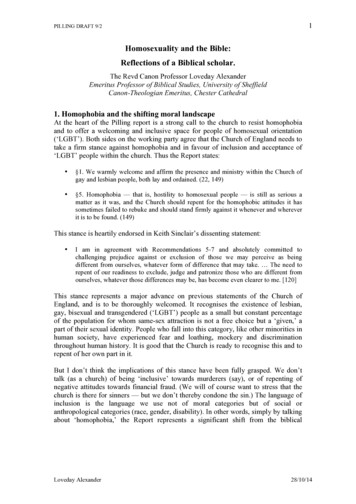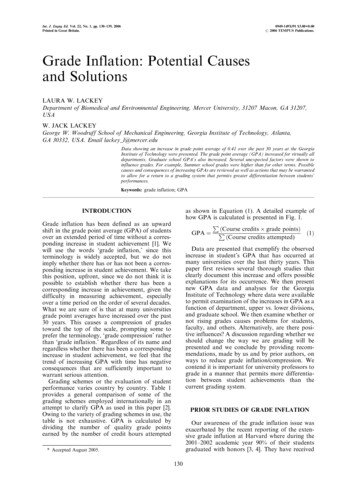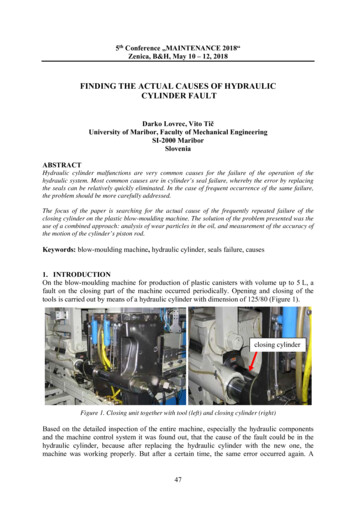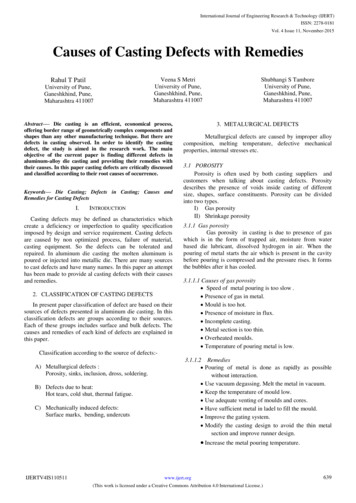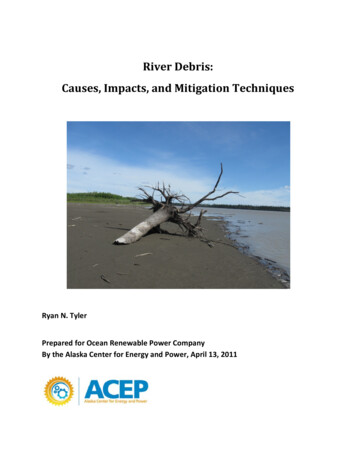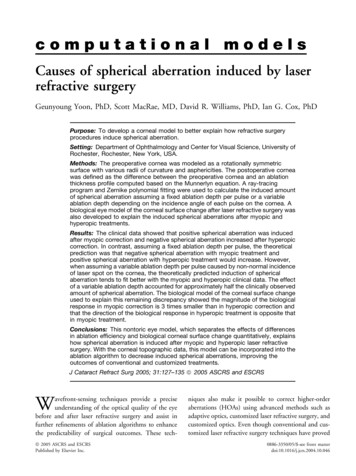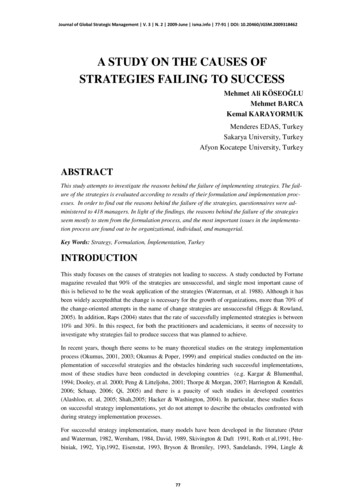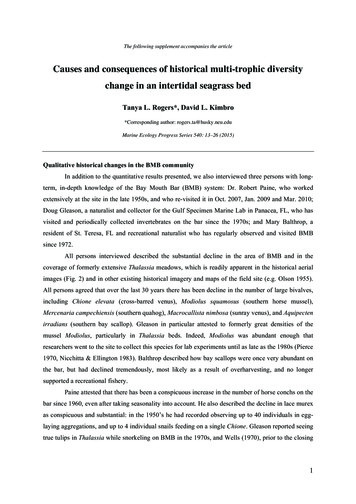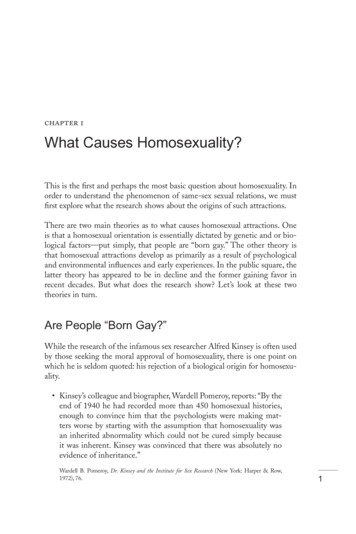
Transcription
What Causes Homosexuality?This is the first and perhaps the most basic question about homosexuality. Inorder to understand the phenomenon of same-sex sexual relations, we mustfirst explore what the research shows about the origins of such attractions.There are two main theories as to what causes homosexual attractions. Oneis that a homosexual orientation is essentially dictated by genetic and or biological factors—put simply, that people are “born gay.” The other theory isthat homosexual attractions develop as primarily as a result of psychologicaland environmental influences and early experiences. In the public square, thelatter theory has appeared to be in decline and the former gaining favor inrecent decades. But what does the research show? Let’s look at these twotheories in turn.Are People “Born Gay?”While the research of the infamous sex researcher Alfred Kinsey is often usedby those seeking the moral approval of homosexuality, there is one point onwhich he is seldom quoted: his rejection of a biological origin for homosexuality. Kinsey’s colleague and biographer, Wardell Pomeroy, reports: “By theend of 1940 he had recorded more than 450 homosexual histories,enough to convince him that the psychologists were making matters worse by starting with the assumption that homosexuality wasan inherited abnormality which could not be cured simply becauseit was inherent. Kinsey was convinced that there was absolutely noevidence of inheritance.”Wardell B. Pomeroy, Dr. Kinsey and the Institute for Sex Research (New York: Harper & Row,1972), 76.1
Alleged evidence of the biological origin of homosexualityA handful of studies published during the 1990s have claimed to offerevidence in favor of a biological or genetic cause for homosexuality. Threeof these in particular—a study of brain structure by Simon LeVay, a studyof twins by J. Michael Bailey and Richard C. Pillard, and a study of “genelinkage” and “gene markers” by a team led by Dean H. Hamer—attractedconsiderable media attention and are largely responsible for the popular beliefthat a “gay gene” has already been found. Let’s look at these in turn.The Brain Studies of Simon LeVaySome researchers have theorized that the sexual preferences and behavior ofhomosexuals may be dictated by the structure of the brain—particularly if thebrains of homosexual men, for example, can be shown to resemble those ofheterosexual women more than they resemble those of heterosexual men.One highly publicized study that purported to demonstrate this was conductedin 1991 by former Salk Institute researcher Simon LeVay. LeVay studied thebrains of cadavers, including 18 men known to have been homosexual and oneknown to have been bisexual. He compared them with the brains of another16 men and six women whom he presumed to have been heterosexual. This iswhat LeVay claimed to have found: “INAH 3 was more than twice as large in the heterosexual men asin the women. It was also, however, more than twice as large in theheterosexual men as in the homosexual men. This finding indicatesthat INAH is dimorphic with sexual orientation [i.e., shows a difference in structure between homosexuals and heterosexuals], atleast in men, and suggests that sexual orientation has a biologicalsubstrate.”Simon LeVay, “A Difference in Hypothalamic Structure Between Heterosexual and HomosexualMen,” Science, 253: 1034 (August 1991).Weaknesses of LeVay’s study2 LeVay’s study, however, suffered from serious methodological errors,including the failure to adequately identify a control group. LeVaymade questionable assumptions regarding the orientation of the“heterosexual” cadavers. He assumed that they were all heterosexual,
even though a number of the allegedly “heterosexual” subjects haddied of AIDS, a disease that remains far more common amonghomosexual men than among heterosexuals: “Sixteen subjects werepresumed to be heterosexual men: six of these subjects died of AIDSand ten of other causes.”LeVay, “A Difference in Hypothalamic Structure Between Heterosexual and Homosexual Men,”1035. Another anomaly of LeVay’s study was the fact that three of the“heterosexuals” had brain clusters smaller than the mean size forthe homosexuals. On the other hand, three of the homosexuals hadlarger clusters than the mean size for “heterosexuals.” Thus, LeVaywas forced to admit, “The existence of ‘exceptions’ in the presentsample (that is, presumed heterosexual men with small INAH 3nuclei, and homosexual men with large ones) hints at the possibilitythat sexual orientation, although an important variable, may not bethe sole determinant of INAH 3 size.”Ibid. LeVay, in fact, admitted that his claim of a correlation between thisbrain structure and sexual orientation could not prove causation, oreven the direction of influence, noting that “[T]he results do notallow one to decide if the size of INAH 3 in an individual is the causeor consequence of that individual’s sexual orientation, or if the size ofINAH 3 and sexual orientation co-vary under the influence of somethird, unidentified variable.”Ibid. All 19 of his homosexual subjects had died of AIDS, and LeVaynoted that another “problem” was “the possibility that AIDS patientsconstitute an unrepresentative subset of gay men, characterized, forexample, by a tendency to engage in sexual relations with large numbers of different partners or by a strong preference for the receptiverole in anal intercourse,” both of which are major risk factors inacquiring human immunodeficiency virus (HIV) infection.Ibid. A related issue is that the allegedly smaller brain clusters mightnot have caused homosexuality, but instead could have resultedfrom sexual activity or AIDS-related brain damage. “[T]here is the3
possibility that the small size of INAH 3 in the homosexual menis the result of AIDS or its complications and is not related to themen’s sexual orientation.” He further allowed that until “tissue fromhomosexual men dying of other causes becomes available, the possibility that the small size of INAH 3 in these men reflects a diseaseeffect that is peculiar to homosexual AIDS patients cannot be rigorously excluded.”Ibid., 1036.Other researchers reject LeVay’s findings William Byne and Bruce Parsons, writing in Archives of General Psychiatry, also raised the question of how AIDS could have impactedLeVay’s subjects, concluding that it is possible to “hypothesize aplausible mechanism by which human immunodeficiency virusinfection” could account for a selective reduction in the volume ofINAH3 in the homosexual men. Byne and Parsons also challenge LeVay’s use of animal studies “tosupport the notion that the INAH3 is crucial to the ‘generation ofmale-typical sexual behavior.’” Finally, they conclude that “LeVay’s study can be faulted for anumber of technical flaws, such as a variable method of tissue fixation, inadequate sexual histories, and small sample sizes.”William Byne and Bruce Parsons, “Human Sexual Orientation: The Biologic Theories Reappraised,” Archives of General Psychiatry, 50: 235 (March 1993).Other Brain StudiesTheories concerning the anterior commissureSince LeVay, researchers have examined other areas of the brain to see if thereare differences between homosexuals and heterosexuals. One study by L. S. Allen and R. A. Gorski (1991) reported thatan area of the brain known as the anterior commissure (AC) “was4
larger in homosexual as opposed to heterosexual men, a finding thatwas interpreted as support for the hypothesis that sexual orientationreflects the sexually differentiated state of the brain.” However, after reviewing the evidence, researchers Mitchell S. Lasco,et al., reported: “We examined the cross-sectional area of the AC inpostmortem material from 120 individuals, and found no variationin the size of the AC with age, HIV status, sex, or sexual orientation.”Mitchell S. Lasco, Theresa J. Jordan, Mark A. Edgar, Carol K. Petito, and William Byne, “ALack of Dimorphism of Sex or Sexual Orientation in the Human Anterior Commissure,” BrainResearch, 936 (2002): 95. Byne and Parsons add that even if Allen and Gorski’s findings couldbe replicated, “the size of the AC alone would tell us nothing aboutan individual’s sexual orientation because the overlap of AC sizebetween homosexual and heterosexual men was tremendous (i.e.,the size of the AC of 27 of 30 homosexual men fell within therange established by 30 heterosexual men). Because these authorsrelied heavily on the brains of the subjects with acquired immunodeficiency syndrome and provide little clinical history, their study issubject to many of the same interpretive difficulties as LeVay’s studyof the hypothalmus.”Byne and Parsons, “Human Sexual Orientation: The Biologic Theories Reappraised,” 235.The suprachiasmatic nucleusByne and Parsons also reject as unsubstantiated a report indicating that thesize of another hypothalamic nucleus, the suprachiasmatic nucleus (SCN), islarger in homosexual than heterosexual men: “Again, however, this study has not been corroborated, and fewstudies of this sort have proved to be replicable in the past. Buteven if corroborated, this finding would not support the prenatalhormonal hypothesis, because in humans the size of the SCN doesnot vary with sex. Furthermore, existing evidence does not suggest aprimary role for the SCN in the regulation of sexual behaviors.”Ibid.5
The corpus callosumByne and Parsons mention yet another attempt to prove that the brain structure of homosexuals differs from that of heterosexuals: “There has also been recent speculation that the morphology ofthe corpus callosum may be found to be female-typical in homosexual men (LeVay. New York Times. October 7, 1991: letter). Suchspeculation is premature as the 23 studies that have sought sexualdimorphism [i.e., differences between men and women] in thecorpus callosum have yielded conflicting results. Although the initialstudy concluded that the splenium of the corpus callosum is larger(P .08) and more bulbous in women than in men, none of the 22subsequent studies replicated the sex difference in splenial size. Furthermore, while some researchers did replicate the finding of a morebulbous splenium in women, others found it more bulbous in menand still others found no sex difference. As described by Byne, someof the negative studies have been unfortunately misinterpreted assuccessful replications.”Byne and Parsons, “Human Sexual Orientation: The Biologic Theories Reappraised,” 235.Conclusion: Brain Studies Byne and Parsons conclude: “In summary, three as yet uncorroborated reports suggest that the size of three different brain structuresmay vary with sexual orientation in men. These reports must beviewed cautiously while replication studies are pending.” Theauthors note further that even if these inconclusive findings wereconsistently replicated, “we will not know whether the anatomic correlates are a cause or a consequence of sexual orientation.”Ibid., 229, 235.The Bailey and Pillard Study of Twins Writing in the Archives of General Psychiatry, J. Michael Bailey andRichard C. Pillard claim to have found a higher rate of homosexuality among identical (“monozygotic”) and fraternal (“dizygotic”)twins than among adoptive siblings. They reported that “of the6
relatives whose sexual orientation could be rated, 52 percent (29/56)of monozygotic cotwins, 22 percent (12/54) of dizygotic cotwins,and 11 percent (6/57) of adoptive brothers were homosexual ”The authors concluded that “the pattern of rates of homosexualityby type of relative was generally consistent with substantial geneticinfluence ”J. Michael Bailey and Richard C. Pillard, “A Genetic Study of Male Sexual Orientation,” Archivesof General Psychiatry, 48 (December 1991): 1089, 1094.The findings of Bailey and Pillard, however, are not entirely consistent witha genetic theory.Methodological deficiencies of Bailey and Pillard Bailey and Pillard themselves alluded to problems with their sampling method: “The sampling method employed in this study fallsshort of the ideal genetic epidemiological study, which would involvesystematic sampling from a well-specified population. In particular,although all recruiting advertisements stated that [subjects] weredesired regardless of the sexual orientation of their relatives, there isno guarantee that volunteers heeded this request.”Bailey and Pillard, “A Genetic Study of Male Sexual Orientation,” 1094. Byne and Parsons confirm that Bailey and Pillard did not employ “asystematically ascertained sample of twins. Subjects were recruitedthrough advertisements placed in homosexual-oriented periodicalsand, therefore, may not be typical of the homosexual population atlarge.”Byne and Parsons, “Human Sexual Orientation: The Biologic Theories Reappraised,” 230.Twin study fails to support genetic hypothesis As Byne and Parsons explain, in Bailey and Pillard’s study, “the concordance rate for homosexuality in nontwin biologic brothers wasonly 9.2 percent—significantly lower than that required by a simplegenetic hypothesis, which, on the basis of shared genetic material,would predict similar concordance rates for dizygotic twins and nontwin biologic brothers. Furthermore, the fact that the concordancerates were similar for nontwin biologic brothers (9.2 percent) and7
genetically unrelated adoptive brothers (11.0 percent) is at odds witha simple genetic hypothesis, which would predict a higher concordance rate for biologic siblings.”Byne and Parsons, “Human Sexual Orientation: The Biologic Theories Reappraised,” 229. Bailey and Pillard themselves admit that the rate of homosexualityamong nontwin biological siblings, as reported by the subjects, was“significantly lower than would be predicted by a simple genetichypothesis and other published reports.”Bailey and Pillard, “A
1 What Causes Homosexuality? This is the first and perhaps the most basic question about homosexuality. In order to understand the phenomenon of same-sex sexual relations, we must
